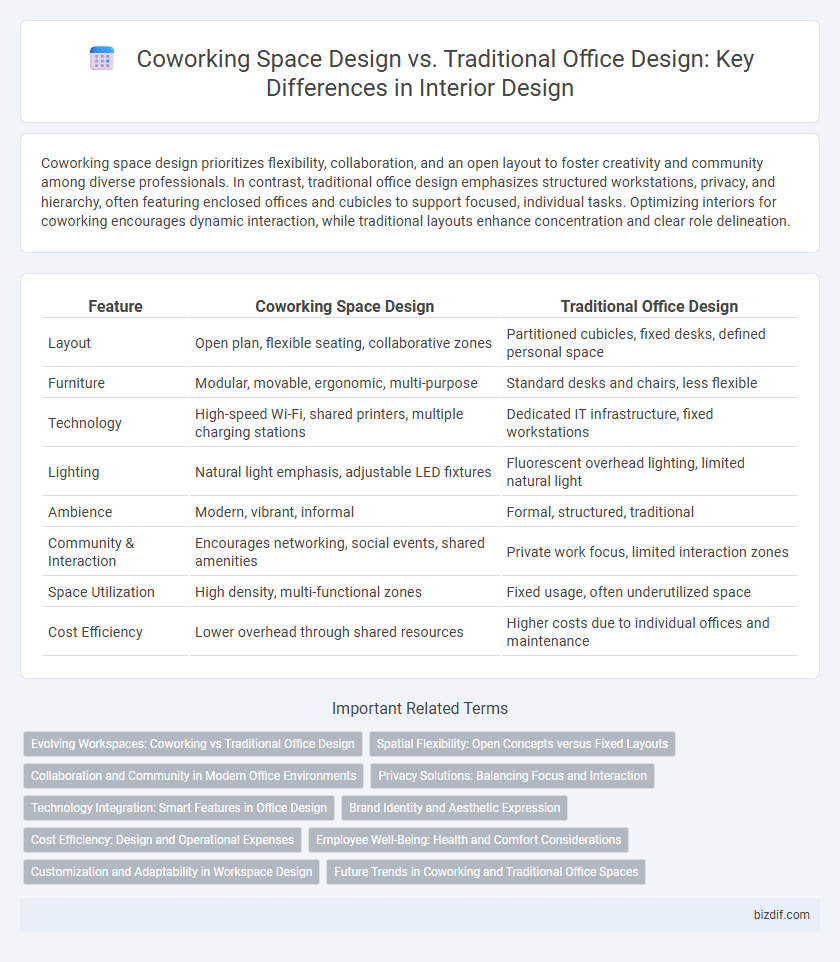Coworking space design prioritizes flexibility, collaboration, and an open layout to foster creativity and community among diverse professionals. In contrast, traditional office design emphasizes structured workstations, privacy, and hierarchy, often featuring enclosed offices and cubicles to support focused, individual tasks. Optimizing interiors for coworking encourages dynamic interaction, while traditional layouts enhance concentration and clear role delineation.
Table of Comparison
| Feature | Coworking Space Design | Traditional Office Design |
|---|---|---|
| Layout | Open plan, flexible seating, collaborative zones | Partitioned cubicles, fixed desks, defined personal space |
| Furniture | Modular, movable, ergonomic, multi-purpose | Standard desks and chairs, less flexible |
| Technology | High-speed Wi-Fi, shared printers, multiple charging stations | Dedicated IT infrastructure, fixed workstations |
| Lighting | Natural light emphasis, adjustable LED fixtures | Fluorescent overhead lighting, limited natural light |
| Ambience | Modern, vibrant, informal | Formal, structured, traditional |
| Community & Interaction | Encourages networking, social events, shared amenities | Private work focus, limited interaction zones |
| Space Utilization | High density, multi-functional zones | Fixed usage, often underutilized space |
| Cost Efficiency | Lower overhead through shared resources | Higher costs due to individual offices and maintenance |
Evolving Workspaces: Coworking vs Traditional Office Design
Coworking space design emphasizes flexibility, collaboration, and community, featuring open layouts, shared amenities, and adaptable workstations that cater to diverse professional needs. Traditional office design prioritizes individual workstations, fixed layouts, and hierarchical organization, often limiting interaction and innovation. The evolving workspace trend favors coworking environments to boost creativity, networking, and employee well-being in response to dynamic business demands.
Spatial Flexibility: Open Concepts versus Fixed Layouts
Coworking space design emphasizes spatial flexibility through open concepts that encourage collaboration and adaptability, allowing users to customize work areas based on immediate needs. In contrast, traditional office design relies on fixed layouts with designated private offices and cubicles, limiting movement and impeding dynamic interaction. Open plans in coworking environments enhance natural light distribution and spatial efficiency, supporting diverse work styles compared to the rigidity of conventional office setups.
Collaboration and Community in Modern Office Environments
Coworking space design fosters collaboration by incorporating open layouts, communal areas, and flexible seating that encourage interaction among diverse professionals. Traditional office design often prioritizes individual workspaces and hierarchical layouts, which can limit spontaneous communication and community building. Modern office environments increasingly adopt coworking principles to enhance teamwork, creativity, and a sense of belonging within the workforce.
Privacy Solutions: Balancing Focus and Interaction
Coworking space design prioritizes flexible privacy solutions such as modular partitions and soundproof pods to balance focus with spontaneous interaction, unlike traditional office design which often relies on fixed cubicles and enclosed meeting rooms. Advanced materials and acoustic treatments in coworking environments reduce noise distractions while encouraging collaboration through open layouts. Privacy management in coworking spaces integrates technology-driven elements like noise-canceling headphones and app-controlled room bookings, enhancing productivity without isolating users.
Technology Integration: Smart Features in Office Design
Coworking space design incorporates advanced technology integration with smart features such as IoT-enabled lighting, AI-driven climate control, and seamless connectivity to enhance flexibility and productivity. Traditional office design often relies on static technology setups with limited automation and less adaptive infrastructure. Emphasizing smart technology in coworking spaces promotes collaboration, energy efficiency, and user-centric environments that traditional offices typically lack.
Brand Identity and Aesthetic Expression
Coworking space design emphasizes flexible layouts and vibrant aesthetics that reflect diverse brand identities, fostering collaboration and creativity. Traditional office design prioritizes uniformity and corporate branding through consistent color schemes and structured layouts, reinforcing a formal company image. Integrating brand identity in coworking spaces leverages dynamic, customizable elements, while traditional offices rely on fixed design elements to convey professionalism.
Cost Efficiency: Design and Operational Expenses
Coworking space design offers significant cost efficiency by maximizing flexible layouts and shared resources, reducing the need for extensive individual office infrastructure. Operational expenses are lowered through communal amenities and scalable services, minimizing utility and maintenance costs compared to traditional office designs. Traditional offices incur higher costs with fixed workstations, dedicated facilities, and less adaptability to changing workforce sizes, resulting in increased capital expenditure and ongoing operational overhead.
Employee Well-Being: Health and Comfort Considerations
Coworking space design prioritizes employee well-being by incorporating flexible layouts, abundant natural light, and ergonomic furniture that reduce stress and enhance comfort. Traditional office design often features rigid workstations and limited communal areas, which can negatively impact mental health and productivity. Integrating biophilic elements and adjustable amenities in coworking spaces supports better air quality, movement, and social interaction, directly contributing to improved health outcomes.
Customization and Adaptability in Workspace Design
Coworking space design emphasizes high customization and adaptability, allowing businesses to tailor layouts and amenities to dynamic team needs and evolving work styles. Unlike traditional office design, which often features fixed, uniform setups with limited flexibility, coworking environments incorporate modular furniture and open floor plans to support diverse activities and collaboration. This adaptability enhances productivity and employee satisfaction by accommodating fluctuating occupancy and fostering a more agile work culture.
Future Trends in Coworking and Traditional Office Spaces
Future trends in coworking space design emphasize flexibility, incorporating modular furniture and technology-enabled hubs to support hybrid work models and collaboration. Traditional office design is shifting towards wellness-centered environments, integrating biophilic elements, improved air quality systems, and ergonomic layouts to enhance employee health and productivity. Both spaces increasingly adopt AI-driven analytics to optimize space utilization and personalize work settings for diverse workforce needs.
Coworking space design vs Traditional office design Infographic

 bizdif.com
bizdif.com